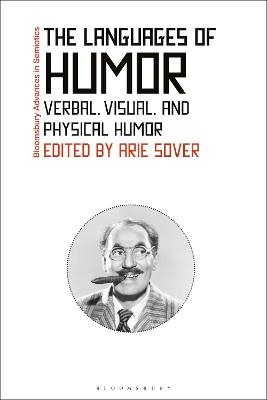
The Languages of Humor
Bloomsbury Academic (Verlag)
978-1-350-15526-8 (ISBN)
Featuring expert authors from across the globe, The Languages of Humor discusses three main types of humour: verbal, visual, and physical. Despite the differences between them, all have a common purpose, showing us in different ways the reality that we live in, and how we can reflect on that reality. To this end, the book shows how humor has been used to address such topics as the Holocaust and the Soviet Union, and why it has been controversial in cases including Charlie Hebdo.
The Languages of Humor explores a subject that is of interest in a wide range of intellectual disciplines including sociology, psychology, communication, philosophy, history, social sciences, linguistics, computer science, literature, theatre, education, and cultural studies. This volume features contributions from world-leading academics, some of who have professional backgrounds in this field. This unique research-led book, which includes over 20 illustrations, offers a top-down analysis of humor studies.
Arie Sover is a Lecturer and Researcher in Communication and Humor Studies at the Open University of Israel, Israel. He is the author and editor of six books (including this one), and numerous articles on humor research. He is also the Founder and Chair of the Israeli Society for Humor Research, and the Founder and Editor of two scientific journals, Humor Mekuvan (in Hebrew), and the Israeli Journal of Humor Research: An International Journal.
Introduction
Part I: Jokes and Joking
1. Jokes and Insults: Language and aggression (Christie Davies, University of Reading, UK)
2. How Jokes Work?: Seven Humor Theorists in Search of a Joke (Arthur Asa Berger, San Francisco State University, USA)
3. God, Jokes, Parnusseh & Tsores: Jewish Humor (Joseph Dorinson, Long Island University, USA)
4. Holocaust Jokes on American and Israeli Situational Comedies: Signalling Positions of Memory Intimacy and Distance (Jeffrey Scott Demsky, San Bernardino Valley College, USA and Liat Steir-Livny, Sapir Academic College and the Open University of Israel, Israel)
5. Intertextuality and Cultural Literacy in Contemporary Political Jokes (Villy Tsakona, Democritus University of Thrace, Greece)
6. Humor and Liminality: A Case Study of the Maltese Gahan (Mary Ann Cassar, University of Malta, Malta)
7. Multifacet Pragmatics of Russian Post-Soviet Jokes (Kravchenko Nataliia, Kiev National Linguistic University, Ukraine, & Pasternak Tetiana Anatoliivna, National University of Life and Environmental Sciences of Ukraine, Ukraine)
Part II: Caricatures and Cartoons
8. Caricature as a Weapon in Class Struggle: Early Soviet Graphic Satire (Annie Gérin, Université du Québec à Montréal, Canada)
9. The Internet Political Meme: A remediation of the political cartoon (Khin-Wee Chen, University of Canterbury, New Zealand)
10. The Interplay Between Visual and Verbal Language in “Famous Last Words” Cartoons (Carla Canestrari)
11. Inside Jokes: Identifying Humorous Cartoon Captions Algorithmically (Dafna Shahaf, Hebrew University of Jerusalem, Israel, Bob Mankoff, Cartoon Editor for The New Yorker Magazine, USA & Eric Horvitz, Technical Fellow and Managing Director at Microsoft Research, USA)
12. Caricature as Desacralization of the Image: The Charlie Hebdo Case (Ayelet Lilti, Elie Wiesel Institute in Paris, France)
Part III: Slapstick and Physical Comedy
13. Slapstick Comedy: Under What Conditions Can Body Movements be Humorous? (Paul Bouissac, University of Toronto, Canada)
14. Slapstick in the American Cinema: From Circus Clowns to the First Cinema Comedians (Arie Sover, Ashkelon Academic College and the Open University, Israel)
15. Slapstick Humor in Children’s Popular Literature (Evangeline E. Nwokah, Vanessa Lopez & Erin Morrison, Our Lady of the Lake University, USA)
16. Shenanigans on Stage: Cultural Re-appropriation of Classical Music through Slapstick (Terri Toles Patkin, Eastern Connecticut State University, USA)
17. Consequential Slapstick: Staging the Aristophanic Slapstick in Lysistrata (Vicky Manteli, Hellenic Open University, Greece)
Bibliography
Index
| Erscheinungsdatum | 16.09.2019 |
|---|---|
| Reihe/Serie | Bloomsbury Advances in Semiotics |
| Zusatzinfo | 20 bw illus |
| Verlagsort | London |
| Sprache | englisch |
| Maße | 156 x 234 mm |
| Gewicht | 472 g |
| Themenwelt | Geisteswissenschaften ► Sprach- / Literaturwissenschaft ► Sprachwissenschaft |
| ISBN-10 | 1-350-15526-8 / 1350155268 |
| ISBN-13 | 978-1-350-15526-8 / 9781350155268 |
| Zustand | Neuware |
| Informationen gemäß Produktsicherheitsverordnung (GPSR) | |
| Haben Sie eine Frage zum Produkt? |
aus dem Bereich


